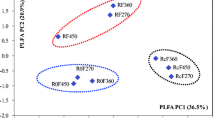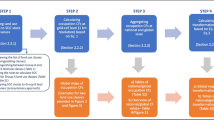Abstract
The intensity of the in situ soil respiration in the background northern taiga spruce forests of the Kola subarctic region reaches 120–290 mg C-CO2/m2 per h. In the impact zone of the Severonikel smelter, it decreases to 90–140, 30, and 15–30 mg C-CO2/m2 per h at the stages of spruce defoliation, spruce-birch woodland, and technogenic barrens of the technogenic succession, respectively. For the first time, the impact of the industrial pollution on root respiration has been assessed, and the dependences of the CO2 emission, the contribution of mineral soil horizons to this process, the microbial biomass, and root respiration on the concentrations of available nickel and copper compounds have been determined. The efficiency of two remediation technologies applied to technogenic barrens near the smelter has been evaluated on the basis of four parameters of the soil biological activity. The results indicate that remediation with the creation of a new filled soil layer is more efficient than chemical and phytoremediation methods.
Similar content being viewed by others
References
V. A. Alekseev, “Diagnostics of the state of the trees and tree stands,” Lesovedenie, No. 4, 51–57 (1989).
E. V. Blagodatskaya, T. V. Pampura, I. N. Bogomolova, G. N. Koptsik, N. V. Lukina, “The impact of emissions from the copper-nickel smelter on the microbial communities of the soils of forest biogenocenoses of the Kola Peninsula,” Izv. Ross. Akad. Nauk, Ser. Biol., No. 2, 232–242 (2008).
D. V. Veselkin, “Distribution of fine roots of coniferous trees in the soil profile under conditions of contamination with emissions from the copper smelter.” Ekologiya, No. 4, 250–253 (2002).
G. A. Evdokimova, G. V. Kalabin, and N. P. Mozgova, “Contents and toxicity of heavy metals in soils of the zone affected by aerial emissions from the Severonikel enterprise,” Eur. Soil Sci. 44(2), 237–244 (2011).
G. A. Evdokimova, E. E. Kislykh, and N. P. Mozgova, Biological Activity of Soils under Conditions of Aerotechnogenic Pollution in the Extreme North (Nauka, Leningrad, 1984) [in Russian].
I. V. Yevdokimov, A. A. Larionova, M. Schmitt, V. O. Lopes de Gerenyu, and M. Bahn, “Determination of root and microbial contributions to the CO2 emission from soil by the substrate-induced respiration method,” Eur. Soil Sci. 43(3), 321–327 (2010).
I. V. Yevdokimov, A. A. Larionova, M. Schmitt, V. O. Lopes de Gerenyu, and M. Bahn, “Experimental assessment of the contribution of plant root respiration to the emission of carbon dioxide from the soil,” Eur. Soil Sci. 43(12), 1373–1381 (2010).
Annual Book of the Kola Mining and Smelting Enterprise No. 6, 25–26 (2008).
G. A. Zavarzin and V. N. Kudeyarov, “Soil as the major source of carbon dioxide and major sink of organic carbon in Russia,” Vestn. Ross. Akad. Nauk 76(1), 14–29 (2006).
G. M. Kashulina, Aerotechnogenic transformation of soils in the European Subarctic region (Izd. KNTs RAN, Apatity, 2002), Vol. 2 [in Russian].
G. N. Koptsik, N. P. Nedbaev, S. V. Koptsik, and I. N. Pavlyuk, “Heavy metal pollution of forest soils by atmospheric emissions of Pechenganikel smelter,” Eur. Soil Sci. 32(8), 896–903 (1998).
N. E. Kuz’menko, V. E. Eremin, and V. A. Popkov, Basics of Chemistry (Ekzamen, Moscow, 2002), Vol. 1 [in Russian].
Ya. V. Kuzyakov and A. A. Larionova, “Contribution of rhizomicrobial and root respiration to the CO2 emission from soil (a review),” Eur. Soil Sci. 39(7), 753–764 (2006).
I. N. Kurganova, Extended Abstract of Doctoral Dissertation in Biology (Moscow, 2010).
A. A. Larionova, L. N. Rozanova, T. S. Demkina, I. V. Evdokimov, S. A. Blagodatskii, “Annual emission of CO2 from gray forest soils,” Eur. Soil Sci. 34(1), 61–68 (2001).
A. A. Larionova, I. V. Evdokimov, I. N. Kurganova, D. V. Sapronov, L. G. Kuznetsova, V. O. Lopes de Gerenju, “Root respiration and its contribution to the CO2 emission from soil,” Eur. Soil Sci. 36(2), 173–184 (2003).
A. A. Larionova, D. V. Sapronov, V. O. Lopes de Gerenju, L. G. Kuznetsova, V. N. Kudeyarov, “Contribution of Plant Root Respiration to the CO2 Emission from Soil,” Eur. Soil Sci. 36(10), 1127–1136 (2006).
I. N. Savel’eva, “Assessment of the spatial variation of the indices of humus status and the biological state of chernozems in the Nazarov Depression,” Pochvoved. Rastenievodstvo, Vestn. KrasGAU, No. 2, 19–27 (2009).
W. H. Smith, Air Pollution and Forests: Interactions between Air Contaminants and Forest Ecosystems, (Springer, New York, 1981).
I. A. Smorkalov and E. L. Vorobeichik, “Soil respiration in forest ecosystems along gradients of soil pollution from copper smelters,” Ekologiya, No. 6, 429–435 (2011).
L. S. Shugalei, “Biological activity of initial soils on dump rocks,” in Productivity and Sustainability of Forest Soils (Petrozavodsk, 2009), pp. 323–324 [in Russian].
S. Brown, B. Christensen, E. Lombi, M. McLaughlin, S. McGrath, J. Colpaert, J. Vangronsveld, “An Inter-Laboratory Study To Test the Ability of Amendments To Reduce the Availability of Cd, Pb, and Zn in Situ,” Environ. Pollut. 138, 34–45 (2005).
R. Clemente, M. P. Bernal, and C. Almela, “A remediation strategy based on active phytoremediation followed by natural attenuation in a soil contaminated by pyrite waste,” Environ. Pollut. 143, 397–406 (2006).
K. E. Giller, E. Witter, and S. P. McGrath, “Heavy metals and soil microbes,” Soil Biol. Biochem. 41, 2031–2037 (2009).
J. E. Hunt, F. M. Kelliher, T. M. McSeveny, D. J. Ross, D. Whitehead, “Long-term carbon exchange in a sparse, seasonally dry tussock grassland,” Gl, Change Biol. 10, 1785–1800 (2004).
D. L. Jones, “Organic acids in the rhizosphere—a critical review,” Plant Soil 205, 25–44 (1998).
K. Kalbitz and B. Marschner, “Controls of bioavailability and biodegradability of dissolved organic matter in soils,” Geoderma 113, 211–235 (2003).
M. Khomik, A. M. Arain, and J. H. McCaughey, “Temporal and spatial variability of soil respiration in a boreal mixed-wood forest,” Agric. Forest Meteorol. 140, 28 (2006).
G. R. Koerber, P. W. Hill, G. Edwards-Jones, and D. L. Jones, “Estimating the component of soil respiration not dependent on living plant roots: comparison of the indirect y-intercept regression approach and direct bare plot approach,” Soil Biol. Biochem. 42, 1835–1841 (2010).
S. Koptsik, G. Koptsik, S. Livantsova, L. Eruslankina, T. Zhmelkova, Zh. Vologdina, “Heavy metals in soils near the nickel smelter: chemistry, spatial variation, and impacts on plant diversity,” J. Environ. Monitor. 5, 441–450 (2003).
G. Koptsik, S. Lofts, E. Karavanova, N. Naumova, M. Rutgers, “Heavy metals in forest soils: speciation, mobility and risk assessment,” in Heavy Metal Contamination of Soil: Problems and Remedies, Ed. by I. Ahmad, S. Hayat, and J. Pitchel (Oxford & IBH Publishing Co. Pvt. Ltd, New Delhi, 2005).
M. V. Kozlov, E. L. Zvereva, and V. E. Zverev, “Impacts of point polluters on terrestrial biota. comparative analysis of 18 contaminated areas,” Environ. Pollut. 15, 107–132 (2009).
K. E. B. O’Connell, S. T. Gower, and J. M. Norman, “Net ecosystem production of two contrasting boreal black spruce forest communities,” Ecosystems 6, 248–260 (2003).
E. J. Sayer and E. V. J. Tanner, “A new approach to trenching experiments for measuring root rhizosphere respiration in a lowland tropical forest,” Soil Biol. Biochem. 42, 347–352 (2010).
Z. Solaiman, “Measurement of microbial biomass and activity in soil,” Soil Biol. 11, 201–211 (2007).
J. A. Subke, M. Reichstein, and J. D. Tenhunen, “Explaining temporal variation in soil CO2 efflux in a mature spruce forest in southern Germany,” Soil Biol. Biochem. 35, 1467–1483 (2003).
P. A. W. Van Hees, R. Finlay, D. L. Jones, D. L. Godbold, U. S. Lundstrom, “The carbon we do not see—the impact of low molecular weight compounds on carbon dynamics and respiration in forest soils: a review,” Soil Biol. Biochem. 37, 1–13 (2005).
Author information
Authors and Affiliations
Corresponding author
Additional information
Original Russian Text © M.S. Kadulin, G.N. Koptsik, 2013, published in Pochvovedenie, 2013, No. 11, pp. 1387–1396.
Rights and permissions
About this article
Cite this article
Kadulin, M.S., Koptsik, G.N. Emission of CO2 by soils in the impact zone of the Severonikel smelter in the Kola subarctic region. Eurasian Soil Sc. 46, 1107–1116 (2013). https://doi.org/10.1134/S1064229313110045
Received:
Published:
Issue Date:
DOI: https://doi.org/10.1134/S1064229313110045




